Throughout London are little reminders of a very different city that once existed. Although nearly all of the city of London was physically lost to fire in 1666, Shakespeare’s London can still be found in the most unexpected ways.
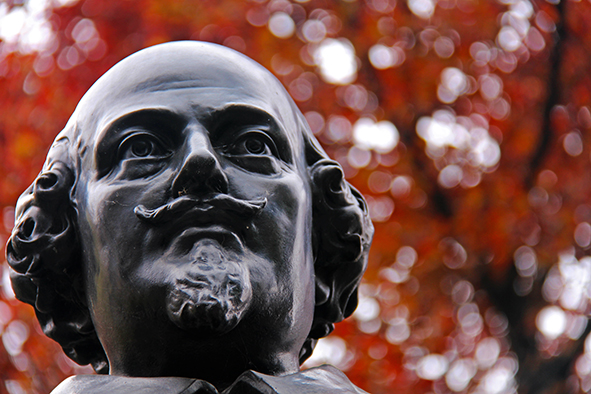
A bust of Shakespeare (Photo: Paul Stafford)
Midday on a Thursday and I’m having a pint in one of London’s oldest surviving pubs. I tell myself that it’s a working lunch because I have a pad of paper beside me. But I’m knocking down the booze far easier than the sentences.
The George Inn is a quaint little pub, ensconced in a courtyard away from the unbearable crush of human bodies around London Bridge station. Now owned by the National Trust, it is London’s only surviving galleried inn with a history dating back well into the 1500s. Water trickles from freshly doused plants in hanging baskets and the sweet post-rain perfume almost has me convinced that I’m somewhere more bucolic.
Many believe The George would have been one of the favoured watering holes, along with the now disappeared White Hart, for the likes of William Shakespeare because of its proximity to the original Globe Theatre. But like much of what is “known” about Shakespeare, it remains unverifiable.
I wonder if Shakespeare also visited the pub during the day to write as I have or did he do the sensible thing and work hard at home, away from temptation, before treating himself to some ale after hitting his daily word count? Something tells me he didn’t really suffer the kind of writer’s mental assault course I experience on a near daily basis. In fact it is assumed that he was one of those rare, gifted writers for whom hand and brain seem seamlessly connected to the point that redrafting was not necessary.
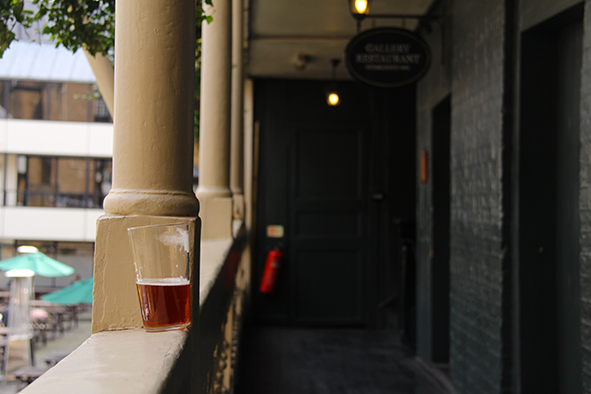
Old wooden galleries at The George Inn make for some precarious pint balancing (Photo: Paul Stafford)
Love and Time
“Much of Shakespeare’s work contains the recurrent themes of love and time.” says Declan McHugh, a Shakespeare expert who runs regular walking tours seeking out Shakespeare’s London. He has been taking me around the city looking for whispers of The Bard.
Love and time are elements that even seem to be present in the modern treatment of Shakespeare’s persona. The global love and reverence for his work surpasses that of all other writers. A global commemoration of 400 years since his death is something few people will ever have. If anything the love for Shakespeare is timeless and without boundary. Once when I was in a bookshop in Beijing a man who spoke very little English came over to ask me where I came from. Upon learning I was English he beamed and said ‘Shaggsbeeah’.
“What’s that now?” I replied.
“Shaggsbeeah. Shaggs-bee-ah!”
“Oh, Shakespeare, yes.” With that he clapped me on the back and ambled off without further comment.
Yet time’s irascible spirit has eroded most facts about the man and his life down to a jumble of myth and apocrypha, deliberated and argued over eternally by legions of self-proclaimed experts to the point of exhaustion, without ever really discovering much that is concrete.
Shakespeare’s Local?
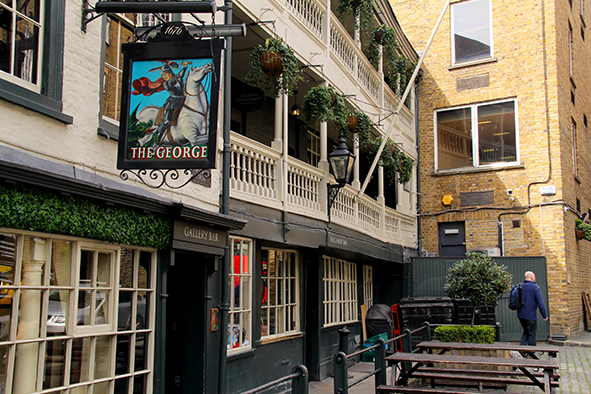
The George in its courtyard (Photo: Paul Stafford)
While it is thought that Shakespeare may have frequented The George and even played in the courtyard, the truth is, nobody really knows for sure whether Shakespeare drank in The George, or in what manner he created his work, or where exactly each piece was written. Much of his life as we know it exists in the form of a question mark. Most of what is known is hopeful guesswork. For me it does not really matter. What does matter is that his work still exists. And so too does the pub, which even has a book written about it called ‘Shakespeare’s Local’, in which author Pete Brown confirms the unverifiable nature of Shakespeare’s favourite watering hole.
Beside me in a wooden frame is a life insurance policy from Charles Dickens who used it, so yet another rumour goes, to pay off a rather sizable bar tab. I start to feel somewhat inferior in the company of these regal literary spirits and I move outdoors to enjoy the emergent sun. I try to imagine what the acoustics are like in the courtyard but stop short of launching into Jaques’ soliloquy from ‘As You Like It’ out of courtesy to the folks on a business lunch at the table beside me. I drain my glass and decide to do a little further exploration instead.
St. George, after whom the pub is named, coincidentally has his patron saint day on April 23rd, the very date on which William Shakespeare died and was perhaps born. But his birth date is just one more thing about the man that has no definite proof. As I leave I smile at the thought that St. George probably did not exist. Yet here he is in alcoholic effigy coupled with Shakespeare, another person who some naysayers also believe to be fictitious. Declan’s disdain for anybody who doubts Shakespeare’s veracity is palpable. Almost immediately from the point we meet he clarifies: “it’s a load of rubbish.”
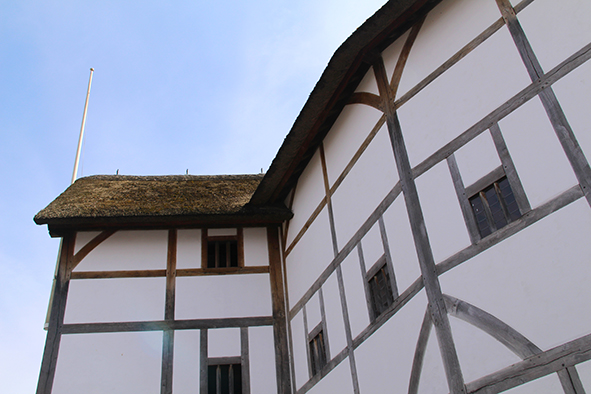
Shakespeare’s Globe – the new version (Photo: Paul Stafford)
Globes and Roses
True relics to Shakespeare are thinly scattered in London. The only known surviving play written in Shakespeare’s own hand can be seen in the British Library’s modern collection along with one of the original folios.
As I wander along the Southbank of the Thames, I keep an eye out for a plaque or something that would announce the site of the first Globe Theatre. It was thought to have been next to Bear Garden, where bear baiting was common practice. The South Bank at the time was outside the jurisdiction of the City of London, where rules were far more stringent and theatres were not appreciated. As such all manner of entertainment from the loftiest soliloquy to the seediest human excretions found a home south of the river.
I find a small alley called Bear Gardens. The next one along is Rose Alley and I know I’m in the right area at least. It was here that the original Rose Theatre would have stood. The Rose was one of the most established theatres in London at the turn of the 17th Century, when Shakespeare was living in London. He staged two of his plays there but the Rose was ultimately the collateral from a little healthy competition between acting troupes at the time.
Edward Alleyn, who frequented the boards at The Rose, was one of the foremost actors of his day until Shakespeare and his favourite actor Richard Burbage – the first Shakespearean actor – came onto the scene. Burbage and Shakespeare were unfathomably popular, the Elizabethan public preferring the gritty tragedies and lewd comedies that they would show at their Globe Theatre, to the historic play bill at The Rose where Christopher Marlowe was the main writer. The Rose closed down in 1606 and was not revived until the 1980s, in much the same fashion as The Globe.
The modern Globe was only opened in 1997 and is not on the original site. I have a look around and am pleased to see that American Sam Wanamaker, without whom the reconstruction may never have happened, had ordered the theatre rebuilt using many of the original methods of construction and materials. A thick layer of auburn moss grows on the thatch roofing, which in itself is unique to London – thatch had been banned in London since the great fire, the exception being made for the sake of Shakespeare.
Inside the theatre itself actors are suspended on wires high above the stage, which is denuded of all set dressing, as they rehearse for the next production. It is so easy to imagine what a similar space would have looked like in Shakespeare’s day, full of people from all walks of life – theatre was not the mainstay of the well-to-do as it seems to be today – drinking and talking and shouting insults at actors they disliked.
I leave the Globe behind in search of less obvious relics of Shakespeare. I wander over the Millennium Bridge to the north side of the Thames. It was to here that Shakespeare eventually moved to escape the less favourable living conditions around the Globe. His move would also mark the start of his best period of writing. Othello, Macbeth and King Lear were all written in his house situated near to the modern day remnants of the London Wall near Barbican. Without Declan as my guide I would never have known it.
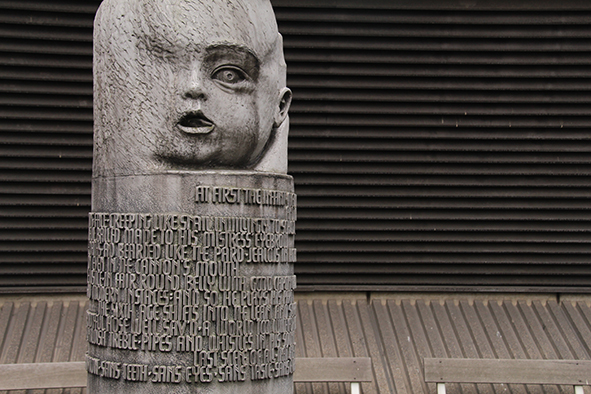
Base of the As You Like It totem pole with Jaques’ soliloquy inscribed (Photo: Paul Stafford)
Whispers of a Charred Past
Many of the buildings from Shakespeare’s time were lost 50 years after his death in the 1666 great fire of London. What paltry vestige remains is hardly even marked out properly, as an exasperated Declan touches on a number of times during his Shakespeare tour of the north bank of the Thames.
“It’s criminal that they keep removing signs about Shakespeare in this city”, he declares. “I have a theory that Stratford Upon Avon must pay London 100 million pounds every year to not publicise Shakespeare here properly” he says wryly. It’s clear that the City of London’s lack of enthusiasm over Shakespeare’s roots in their borough frustrates him.
We had begun at Blackfriar’s and were now wandering past a number of sites where Shakespeare was known to have lived or frequented. None of which would I ever have found myself; they don’t have any plaques or markings after all. Down little alleys and into rather sombre courtyards, the world of Shakespeare is gradually unravelled. Having led the tour for 17 years and done much of the research for himself, Declan’s knowledge and insight far surpasses the normal stories often told by companies to boost their own standing by claiming Shakespeare as one of their very own.
Shakespeare was actually extremely wealthy in his time. He made most of his money not, as many would expect, from his writing, but through his part ownership of The Globe Theatre. For Hamlet he received the equivalent of about £600 in modern day money for example; a paltry sum for a work that has known four centuries of sheer reverence.
Declan led the way through more alleys twisting into a courtyard that once housed the King’s Wardrobe, which acted like a clothing drive for actors. Later we stopped before a totem pole dedicated to the famous speech from ‘As You Like It’ that starts “All the world’s a stage”. At 35 years old Shakespeare had a profound concept of the human condition in all its complexity. Declan launches into the speech, recasting centuries old verse to contemporary ears.
The London of then, with its 200,000 people probably mirrored that of today in terms of its humanity. The stage was everywhere then as it is now. I suddenly become more aware of my surroundings, of the people and their concerns, worries, hopes and joys. It no longer matters that many of the historical landmarks have been lost, because what Shakespeare has given us is more immediate – tools to make sense of the people around us. The stage goes on and on. The curtain never falls.
Across the road is the Church of Scientology. It looks quiet and rather unassuming. People hurry to and fro desperate to make the most of their lunch hour. Tourists amble along the river’s edge snapping photos and taking in the cityscape. The human experience in its broadest terms fully represented by someone, somewhere close by.
In ‘As You Like It’ Shakespeare wrote “one man in his time plays many parts”, but centuries later he continues to play a multitude of parts beyond his own design. His role changes depending on the individual: villain, impostor, immortal bard or the greatest Brit of all time. Perhaps it is in this continued ambiguity that each person finds their own truth, wandering along London’s modern limbs looking for glimpses of Shakespeare’s lost capital, or sat in an ale house drinking oneself closer to a communion with great spirits.
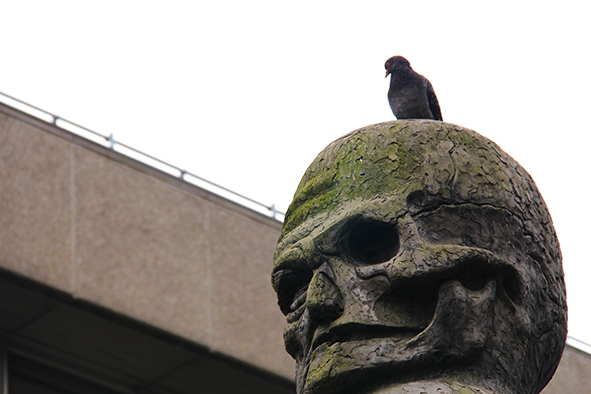
Top of the totem ode to As You Like It (Photo: Paul Stafford)
Further Information:
Declan McHugh runs his ‘Shakespeare in the City’ walks every Friday at 11am starting from Blackfriar’s Station. It is also possible to book private tours on other days.
The British Library collection is free to enter.
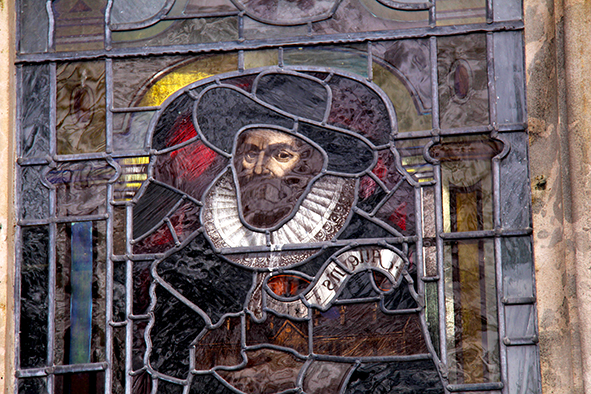
Edward Alleyn despicted in stained glass at St. Giles Cripplegate Church (Photo: Paul Stafford)